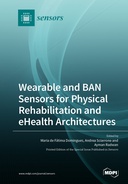Explore

Wearable and BAN Sensors for Physical Rehabilitation and eHealth Architectures
0 Ungluers have
Faved this Work
Login to Fave
The demographic shift of the population towards an increase in the number of elderly citizens, together with the sedentary lifestyle we are adopting, is reflected in the increasingly debilitated physical health of the population. The resulting physical impairments require rehabilitation therapies which may be assisted by the use of wearable sensors or body area network sensors (BANs). The use of novel technology for medical therapies can also contribute to reducing the costs in healthcare systems and decrease patient overflow in medical centers. Sensors are the primary enablers of any wearable medical device, with a central role in eHealth architectures. The accuracy of the acquired data depends on the sensors; hence, when considering wearable and BAN sensing integration, they must be proven to be accurate and reliable solutions. This book is a collection of works focusing on the current state-of-the-art of BANs and wearable sensing devices for physical rehabilitation of impaired or debilitated citizens. The manuscripts that compose this book report on the advances in the research related to different sensing technologies (optical or electronic) and body area network sensors (BANs), their design and implementation, advanced signal processing techniques, and the application of these technologies in areas such as physical rehabilitation, robotics, medical diagnostics, and therapy.
This book is included in DOAB.
Why read this book? Have your say.
You must be logged in to comment.
Rights Information
Are you the author or publisher of this work? If so, you can claim it as yours by registering as an Unglue.it rights holder.Downloads
This work has been downloaded 179 times via unglue.it ebook links.
- 179 - pdf (CC BY) at Unglue.it.
Keywords
- accelerometers
- Aging
- anomaly detection
- anterior shoulder instability
- Bland–Altman plots
- body sensor network
- cardio-respiratory monitoring
- Cloud computing
- COPD
- Data fusion
- E-Health
- electrocardiogram
- electromyographic biofeedback
- Energy Expenditure
- fog computing
- gait analysis
- gait speed
- gyroscope
- Healthcare
- Heart Rate
- Heart rate variability
- Hidden Markov Model
- History of engineering & technology
- human activity recognition
- IMU
- inertial sensor
- inertial sensors
- information fusion
- interclass correlation coefficient
- Internet of Things
- low frequency extension filter
- Machine learning
- motion reconstruction
- n/a
- obstacle detection
- open set classification
- out of distribution
- paddle stroke analysis
- physical activity
- Physiotherapy
- Rehabilitation
- respiratory rate
- rotator cuff related pain syndrome
- scapula neuromuscular activity and control
- scapular dyskinesis
- SenseWear Armband
- smart textile
- smart walker
- smart watch
- Stepwatch
- Stress
- Technology, engineering, agriculture
- Technology: general issues
- Wearable Device
- Wearable sensors
- wearable system
- weekday-to-weekend
Links
DOI: 10.3390/books978-3-0365-2813-7Editions

